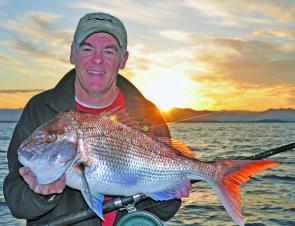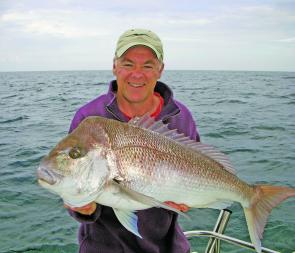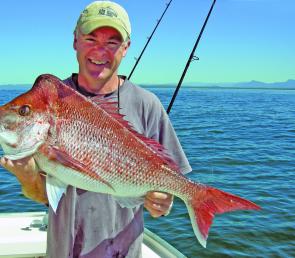It’s probably fair to say that most sheds, garages and tackle cupboards in Australia have an Alvey sidecast or two lurking in them. They’re as iconic as football, meat pies, kangaroos and Holden cars, and are definitely our national reel.
Most Alveys get used for rock and beach fishing; their simple, no-nonsense design being at home where sand and salt water are constantly on the attack.
But different models have a strong offshore following.
Large diameter Alvey boat reels and deck winches have long been popular for deepwater reef fishing but a select band, including myself, use the smaller estuary sidecasts for ‘floater’ fishing for snapper and other species in shallower water.
My mates think I’m decidedly odd and a bit old-school for fishing this way, and are always making disparaging remarks about my using a ‘dog’s dish’ for snapper.
But an Alvey does have a number of advantages over threadlines and overheads when fishing floating baits.
I have two 6” Alveys for snappering – a stainless steel 600A with a fibreglass spool, and an all-graphite 600B. The graphite one is lighter and therefore mostly hand-held, while the other sits in a rod holder.
Both reels hold 500m of 7kg line, so they still hold plenty of 10kg and heaps of 6kg.
Unfortunately, the blank number of the 600A rod I use is lost in the mists of time, but the blank for the graphite reel is a Pacific Composites SB 8.
Both are fitted with low reel mounts, are 2.45m (a smidgen over 8’) long and are what old-timers would have once described as ‘wash’ rods.
They can handle a variety of casting weights, from none at all to wrecking balls.
Line breaking strain has crept up over the years.
Off Sydney, it was possible to fish 5kg to 6kg line for much of the time but around Coffs Harbour it proved a different story. Before moving here, semi-regular visits soon revealed a little additional firepower was needed.
This was a consequence of the size of the fish present and the terrain they lived in, so 7kg was a logical stepping-stone. After a few heart-breaking losses, however, this was soon increased to 10kg.
The second outfit even had 15kg on it for a time and while the increase in diameter didn’t produce fewer bites, it wasn’t possible to apply sufficient pressure to warrant the increase in line class so I’ve gone back to 10kg. I was also worried about snapping the rod.
Sometimes, however, a rod length of 15kg mono can be handy if fishing shallow and the snapper need to be physically dragged back out of the kelp.
The 600A and B series don’t have drag systems as such and this is what makes them such fun to use.
It’s you versus the fish, with no drag doing the work for you.
Screaming, out-of-control runs, with the blurred handles bashing your fingers and the spool burning a furrow in the fleshy part beneath the thumb, are just part of these reels’ masochistic appeal.
You hook a big red and immediately you heart’s in your mouth; you wonder just how close that line is to the reef or kelp. Then the fish stops, you get a couple of tentative winds on the spool and recover maybe half a metre of line, then off it goes again, but not so far this time.
If you’re still connected, barring any unforseen circumstances, you’re in with a show of putting that big knobby in the net.
While still a popular choice, the drawback with floater fishing with threadlines is that as the line load on the spool diminishes, the line has to pull over the spool lip. This increases resistance that can have the bait holding up in the current and out of the bite zone.
In deeper water, overheads will probably need a fairly weighty bait and/or sinker to get them ticking over.
With an Alvey, though, it’s possible to spin off a metre of slack with the flick of the spool to get the bait sinking unimpeded and looking as natural as possible.
An alternative approach is to cast out, leave the spool in the casting position, sit the outfit in the holder, and allow the bait to descend under its own steam. Hopefully, before it hits the bottom, the line is flicking off the spool in a blur.
Getting the reel turned around can be a little difficult, though!
When fishing an overhead reel without a levelwind, it is considered an unpardonable sin to allow the line to pile up in the centre of the spool.
When fishing floaters off an Alvey however, it can actually be a distinct advantage.
Snapper often park themselves at a particular depth, so as the hill of line diminishes you can prepare yourself for the bite and therefore fish more efficiently.
There are, of course, some drawbacks. The first is hooking a yellowtail kingfish, samson, cobia or mackerel tuna. These are painful and a lot of hard work, fighting all the way to the boat.
Even bonito are bad news. At least snapper go relatively quietly after the tension-filled first few minutes and you’ve worked them clear of the bottom.
Equipped with a minimum of moving parts, there isn’t a lot to go wrong with an Alvey.
While swishing them around in the wash on a surf beach (as demonstrated in the old TV ads) is probably not best practice, maintenance is pretty simple.
In fact, on my reels it’s almost non-existent. I haven’t had the spools off my pair for years, except to periodically fish out stray loops that sneak in when the reel is chockers full of fresh, springy line.
The only parts that need replacing are the ratchet springs and the occasional bent handle screw. Both are indicators of encounters with big fish.
Despite years of familiarity, I still occasionally manage to get line around the handles, which is both comical for anyone watching and nerve-wracking for me.
The rest of the time, though, it’s just fun all the way.
Facts
THE LINE TWIST BOGEY
On the advice of others, I’d always incorporated a swivel above the sinker and hooks, but then one day I got to wondering if line twist with Alveys was just an urban myth.
I fished the line straight through to the hooks to see what happened and, you guessed it, line twist. Not heaps, but just enough to be annoying. A swivel above the terminals certainly makes a world of difference.
Start off with the swivel about three-quarters of a rod length away from the hooks when fishing floaters, as you’ll most likely need to re-tie a couple of times during the day, certainly after every big fish, or when the red rockies and sergeant bakers have been gnawing away at the leader.
Facts
With pic 7
FLOATER RIG HOOKS
Whether fishing pilchards or tuna strips, I prefer a two-hook rig to provide more coverage through the bait. Mustad 542s in 3/0 and 4/0 are a good combination, and the reason for the slight mismatch in hook sizes is that the No 10 swivel used to connect the two can be forced over the barb of the smaller hook, and then only the eye of the bottom hook needs to be opened to complete the rig.
If the bait or the fish are especially big, you could use a 4/0 top hook but that would entail opening the eye to get the swivel on, and no matter how hard you squeeze with a pair of pliers it will never be shut as well as when it left the factory. This can create a sharp edge that could damage the knot. The addition of another barrel swivel would, however, avoid this potential problem and give the line something smooth to connect to.
Again, like the Alveys, the Mustad 542s might be considered old school. They’re not chemically sharpened and they’re not made of some exotic metal composite so they do rust. But they are bloody strong, which is what you need when the peg-toothed jaws of a big red are crunching away on them during the fight.
When making up these gangs, be aware that there are swivels and there are swivels. The eye diameter can vary quite markedly from brand to brand, meaning it can slip back off the first hook. Consequently, it pays to give the swivel eye a slight nip with the side-cutters just to close the gap.
A pair of 3/0 and 4/0 Mustad 542 hooks linked with a No 10 barrel swivel is a good way of fishing pillies and strip baits. As you can see, though, swivel quality is a bit hit-and-miss these days. Fortunately, the snapper was also pinned by the top hook.

‘It’s the Alvey reel that fills the creel’. A nice little morning session on floaters, with the big brute at right weighing in at 9.2kg – the others aren’t bad fish, either!

Now that was fun! The stinging fingers and bruised thumb hardly register after landing a quality fish like this. Only a constantly attended handline can fish a floating bait as successfully.

A lovely, calm late Winter afternoon, a light current, a prawn shell and chook pellet berley and the reds are in the trail.

Get him up! Get him up! The first few minutes of an Alvey hook-up on a big red are a frantic, heart-in-the-mouth experience.

At 8.3kg that’s not a bad fish, but quite a bit shy of the magical 20lb mark. The author says it went like stink on the Alvey, though.

Thanks to their prodigious line capacity, Alveys are also effective for fishing floater baits in deep water. This 6.5kg knobby came out of 28 fathoms and was mixed in with a school of mid-morning teraglin.

with fact box




